Stochastic programming is used to solve optimization problems in which the majority of the parameters are probabilistic. Probabilistic optimization can make efficient use of information, both in terms of selecting evaluation points and the message they convey. It can handle many sorts of noise and adapts to various aspects of optimization issues. Unlike deterministic optimization, probabilistic optimization techniques discover the best solution for data with randomness.
- probabilistic optimization
1. Probabilistic Optimization
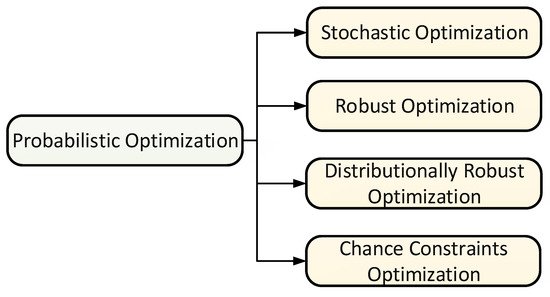
1.1. Stochastic Optimization
1.1.1. Architecture of Stochastic Optimization
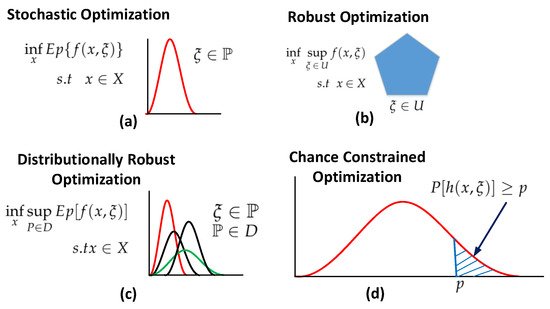
1.1.2. Taxonomy of Stochastic Optimization
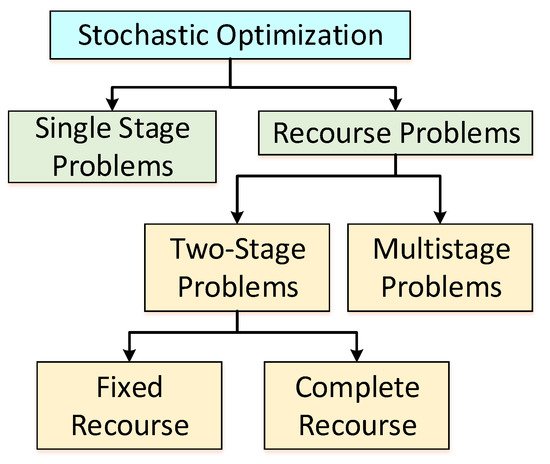
1.2. Robust Optimization
1.2.1. Architecture of Robust Optimization
1.2.2. Taxonomy of Robust Optimization

-
Strict robustness: This optimization type is sometimes known as classic robust optimization, min–max optimization, absolute deviation, one-stage robustness, or simply robust optimization. It is treated, as the fundamental starting point in the area of robustness. A solution x is called strictly robust if it is feasible for all possible scenarios of uncertainty set U [40].
-
Cardinality constrained Robustness: In cardinality constrained robustness, reduction in uncertainty’s space can relax strictness in robust optimization. Analyzing the worst-case scenario in robust optimization, it is improbable that all the uncertainty set parameters will change simultaneously. Hence, it restricts uncertainty space by varying some parameters while considering fixed values for the remaining [41].
-
Adjustable robustness: In adjustable robustness, the uncertainty space of strict robustness gets relaxed by dividing uncertainty space into groups of variables such as here and now and wait-and-see. Variables from the here and now group must be evaluated before the scenario ξ∈U is determined where variables from the wait-and-see group can be determined once the scenario ξ is known [42].
-
Light robustness:In light robustness, relaxing the constraints in terms of quality can reduce the strictness of the robust optimization, rather than reducing the space of uncertainty. Light robustness develops a trade-off between quality and robustness of the solution [43].
-
Regret robustness: In regret robustness, the objective function relaxes the problem. Rather than to minimize the worst case performance of the solution, regret robustness reduces the difference of objective function having the best solution and the objective function that would have been possible in a scenario [44].
-
Recoverable robustness: Concept of recovery algorithm gets exploited in recoverable robustness and family of recovery algorithms which is represented by B. It provides the solution in two stages, such as adjustable robustness. A solution x is called recovery robust with respect to recovery algorithm A if for any probable situation ξ∈U an algorithm A∈B exist such that when A is applied to the solution x and the scenario ξ makes a solution A(x;ξ)∈F(ξ) [45].
1.3. Distributionally Robust Optimization
1.3.1. Architecture of Distributionally Robust Optimization
1.3.2. Taxonomy of Distributionally Robust Optimization
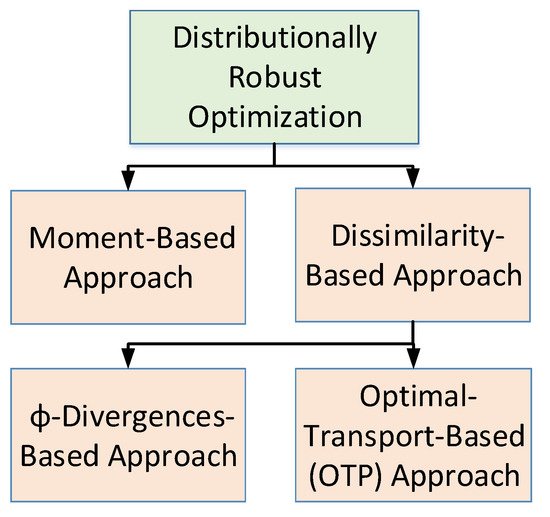
- (1)
-
Moment-based approach: The ambiguity set in moment based approach is the set of all probability distributions whose moments satisfy certain constraints [
(1) Moment-based approach: The ambiguity set in moment based approach is the set of all probability distributions whose moments satisfy certain constraints [
,
- 49].
- (2)
-
Dissimilarity-based approach: The ambiguity set in this case is the set of all probability distributions whose dissimilarity to a nominal distribution is lower than or equal to a given value. In this category, the choice of the dissimilarity function leads to couple of different variants which are as follows [
].
(2) Dissimilarity-based approach: The ambiguity set in this case is the set of all probability distributions whose dissimilarity to a nominal distribution is lower than or equal to a given value. In this category, the choice of the dissimilarity function leads to couple of different variants which are as follows [
- 47].
].
2.2. Applications, Objectives and Solution Algorithms of Robust Optimization
| Ref. | Applications | LP | NLP | MIP | MILP | MINLP | MIBLP | MISOCP | MIQP | QP | |||||||||||||||||
|---|---|---|---|---|---|---|---|---|---|---|---|---|---|---|---|---|---|---|---|---|---|---|---|---|---|---|---|
| DD and IGDT | MPC and FPIM | BB | LM | QP | MCS | LOM and BMLM | IM | ||||||||||||||||||||
| [69] | |||||||||||||||||||||||||||
| [92 | SGEM | , | 106,107 | × | ] | Minimize Generation Cost | |||||||||||||||||||||
| × | × | [70,71,72,73,75] | MEM | × | |||||||||||||||||||||||
| [ | × | 89,91 | ] | × | |||||||||||||||||||||||
| Minimize Electricity Cost | × | × | [90,91] | HEM | |||||||||||||||||||||||
| [76 | × | ] | Minimize Social Benefits Cost | ||||||||||||||||||||||||
| × | × | [88,89,93] | DSM | × | × | × | |||||||||||||||||||||
| [73,77] | Minimize Microgrid Net Cost | × | × | [92,94] | PEV | × | × | ||||||||||||||||||||
| [90] | Minimize Comfort Violation | × | ,66] | ||||||||||||||||||||||||
| [67,78,83, | UC | 84,85,87,95, | × | 96,97,98,99,104] | UC | 100,101 | × | ,102, | |||||||||||||||||||
| 103, | × | × | × | × | × | × | [60] | STG | × | ||||||||||||||||||
| [65] | RDG | × |
| [ | ||||||||
| 105 | ||||||||
| ] | ||||||||
| SGTD | ||||||||
| × |
- (a) Optimal-transport-based (OTP) approach: The authors in [
- ,
- ] applied Wasserstein distance as a dissimilarity function which shows some nice statistical convergence properties.
- (b) ϕ-Divergences based approach: This group consist of all those techniques which uses ϕ-divergences such as Kullback–Leibler divergence, as was described in [52,53]. Approaches used in [54,55] are based on likelihood which also belongs to this category.
1.4. Chance Constrained Optimization
1.4.1. Architecture of Chance Constrained Optimization
1.4.2. Taxonomy of Chance Constrained Optimization
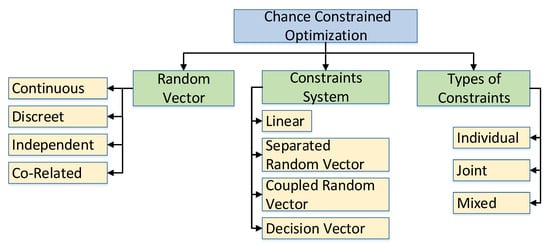
2. Applications, Objectives and Solution Algorithms of Probabilistic Optimization
2.1. Applications, Objectives and Solution Algorithms of Stochastic Optimization
| References | Applications | LP | NLP | MILP | MISOCP | MIQP |
|---|
| Ref. | Objectives | SAA | AM | SBM | IPM | HE | BD and DE | HABC | POC | DD | SA | SVM | LR and IM | MDP | MCS | MDP | ADMM | |||||||
|---|---|---|---|---|---|---|---|---|---|---|---|---|---|---|---|---|---|---|---|---|---|---|---|---|
| [59] | HEM | × | ||||||||||||||||||||||
| [106,130] | Minimize Generation Cost | × | × | [61] | MEM | × | ||||||||||||||||||
| [68] | OPF | × | ||||||||||||||||||||||
| [62,63] | DRM | × | ||||||||||||||||||||||
| [23 | ||||||||||||||||||||||||
| [67,71,75,81,82,83,84,86,98,110] | Minimize Overall Cost | × | × | × | × | × | × | × | ||||||||||||||||
| [93] | Minimize Electricity Payment | × | × | |||||||||||||||||||||
| [69,87] | Maximize Social Welfare | × | × | |||||||||||||||||||||
| [75] | Maximize Profits | × |
2.2.1. Smart Grid Energy Management
2.2.2. Microgrid Energy Management
2.2.3. Unit Commitment
2.2.4. Demand Side Management
2.2.5. Smart Home
2.2.6. Plugin Electric Vehicles
2.3. Applications, Objectives and Solution Algorithms of Distributionally Robust Optimization
2.4. Applications, Objectives and Solution Algorithms of Chance Constrained Optimization
| Ref. | Applications | LP | NLP | MIP | MILP | MINLP | MIBLP | MISOCP | SOCP | MIQP | ||||||||||||||||||
|---|---|---|---|---|---|---|---|---|---|---|---|---|---|---|---|---|---|---|---|---|---|---|---|---|---|---|---|---|
| [115,116,117,118,142,143] | MEM | × | × | × | × | × | ||||||||||||||||||||||
| [129] | HEM | × | ||||||||||||||||||||||||||
| ,64] | ||||||||||||||||||||||||||||
| [119,120,121,123,124] | DEM | × | × | × | ||||||||||||||||||||||||
| [127,128] | SDN | × | × | |||||||||||||||||||||||||
| [133] | Constraints Satisfaction | × | ||||||||||||||||||||||||||
| [131,132] | Minimize Reserve Cost | × | × | [125,126] | ED | × | DSM | |||||||||||||||||||||
| [125] | Minimize Signal Price | × | × | |||||||||||||||||||||||||
| [ | 142] | Minimize Electricity Cost | × | [24 | ||||||||||||||||||||||||
| [141] | PEV | |||||||||||||||||||||||||||
| [115, | × | |||||||||||||||||||||||||||
| 118,134,135] | Minimize Operating Cost | × | × | × | [138] | |||||||||||||||||||||||
| [116, | ED | × | 117 | , | ||||||||||||||||||||||||
| 119,120,123,127,136,144,148] | Minimize Overall Cost | × | × | × | × | × | × | [130,131,133,134,135,136,137,144] | UC | × | × | × | × | × | ||||||||||||||
| [ | 121] | Minimize Thermal line losses | × | |||||||||||||||||||||||||
| × | [145] | |||||||||||||||||||||||||||
| [128 | GEM | × | ] | Minimize planning cost | ||||||||||||||||||||||||
| × | [146] | OPF | × | |||||||||||||||||||||||||
| [139] | Minimize Active Power Losses | × | × | [147] | OPGF | × |
| [ | |||||||||||||||||
| 140 | |||||||||||||||||
| ] | |||||||||||||||||
| Maximize payoff | |||||||||||||||||
| × | |||||||||||||||||
| [145] | Minimize Dispatch cost | × | |||||||||||||||
| [149] | Minimize Social cost | × |
